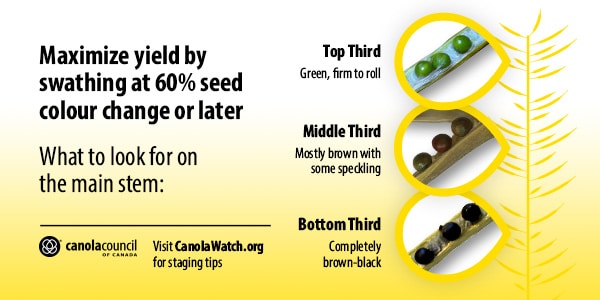The art and science of timing end-of-season management just right
Challenging early and mid-season weather conditions mean some canola acres are a variety of colours and maturities. To assess optimal swath timing, look to where the majority of yield is coming from, both in the field and on the plant, then plan to swath when those pods reach 60% seed colour change. While no registered products will speed up or even-out maturity, applying the right pre-harvest aid (based on field conditions, harvest plan and weather forecast) at the right time can:
- speed dry-down (Reglone – Group 22 diquat)
- control perennial weeds (pre-harvest glyphosate)
- support dry-down and annual weed control (Heat LQ – Group 14 saflufenacil)
For optimal timing, contact the chemical rep. Check Keep it Clean’s spray-to-swath calculator and pre-harvest glyphosate staging guide. (Swath or straight combine) (Best timing for perennial weed control)

What to plant next year?
While it can be very tempting to choose cultivars based on yield potential first, gaining two or three percent in yield but losing 10, 15 or more percent to disease or another issue is a costly loss overall. CCC’s Agronomy Director Clint Jurke recommends this four-step process to choose the optimal cultivars:
- FIRST- choose traits that control the most important yield robbers in that field (disease, weeds, days to harvest).
- NEXT- choose traits based on rotation requirements (ie: herbicide tolerance, clubroot & blackleg resistance)
- THIRD – select based on yield or traits that offer a price premium
- LAST – choose traits that are nice to have (harvestability, standability, etc.)
(Use clubroot-resistant canola early to keep spores low) (Choose the right cultivar for each field)
Prep now for storage
Swathers and the very first combines are beginning to roll across the Prairies, which means canola will soon be filling bags and bins. Now is the time to confirm storage equipment is ready to receive: double-check that bins are prepared and clean, that the inventory of bags is sufficient, that all aeration fans are functional, and that all grain handling, bagging, and bin monitoring equipment is in good working order. Remember that, due to residue concerns, canola should never be stored in bins that have been treated with malathion during the current growing season. In case summery warmth continues into fall, be ready to manage canola that is binned hot. (5 simple storage tips) (Bin prep) (Factors that increase canola storage risk)
Late-season evaluation: disease management and more
Late season is an excellent time to assess which management choices proved successful this year and what might need tweaking in a future year. Use each and every trip through the field at pre- and post-swathing as an opportunity to scout.
Sclerotinia is widespread in moister areas. Verticillium stripe risk is increasing – look for prematurely ripe patches or unevenly mature fields. Blackleg is easy to misdiagnose once the plant is dried-down, so scout carefully before and at swathing and send samples to a lab for analysis. (Disease ID tips for pre-harvest scouting) (Canola disease scouting pre- and post-swathing)
While walking fields, pre-plan how best to collect data from check-strips and other on-farm evaluations. On-farm trials (which, ideally, should be replicated trials) are a tremendous opportunity to learn from a crop and tailor management to a specific field. And, get ready to count stems at/after harvest.
